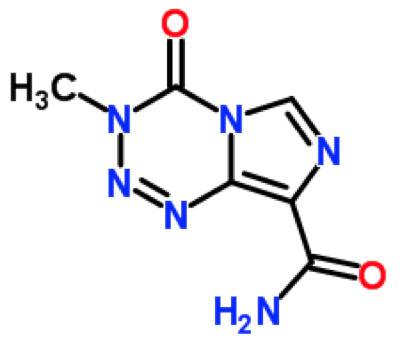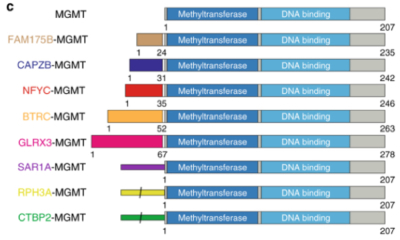Chemotherapeutic drug resistance is one reason cancer remains an unsolved clinical problem despite the efforts ever since President Nixon declared his "War on Cancer" in 1971. Cancer cells, due in part to the genetic destabilization characteristic of the disease, are capable of expressing genes (normal or aberrant) that permit the cell to avoid the cytotoxic effect of such drugs with the patient providing the situs of selection for and growth of resistant cells. The phenomenon is certain tumor types can have more deleterious consequences than in others, and this is particularly true for glioblastomas (and their non-malignant counterparts, gliomas), cancer of the cells that protect neurons in brain. That organ, confined to the skull, cannot accommodate tumor growth without damaging the brain with which it is confined.

The chemotherapeutic drug of choice for treating glioblastomas is temezolomide (TMZ), an oral alkylating agent that had its chemotherapeutic effect by introducing alkyl groups onto nucleotide bases (preferably at the N-7 and O-6 positions of guanine and N-3 position of adenine) in tumor cell DNA preferentially (due to the greater amount of DNA synthesis occurring in these cells) and disrupting the process leading to cell death (the O-6 methylation having the greatest capacity to induce apoptosis or programmed cell death).  O-6-methylguanosnine DNA methyltransferase (MGMT) is the cellular enzyme responsible for repairing alkylated bases in DNA and reduced expression of this gene (e.g., by hypermethylation of the MGMT promoter) is a biomarker for TMZ sensitivity in gliomas and glioblastomas. Recently, a multinational team of researchers* reported genetic rearrangements associated with TMZ resistance, in a paper entitled "MGMT genomic rearrangements contribute to chemotherapy resistance in gliomas" published in Nature Communications. This paper shows a subset of gliomas with rearrangements in the MGMT gene that produce overexpression of the gene and resistance as a result. These authors screened 252 TMZ-treated recurrent gliomas by RNA sequencing and found eight different MGMT genetic fusions (designated BTRC-MGMT, CAPZB-MGMT, GLRX3-MGMT, NFYC-MGMT, RPH3A-MGMT, and SAR1A-MGMT in high-grade gliomas, HGG, and CTBP2-MGMT and FAM175B-MGMT in low-grade gliomas, LGG, in the paper) in seven patients (6 females) with recurrent disease, created by chromosomal rearrangement (see Figure 1c from paper; shown below). These individuals' tumors showed "significantly higher" expression of the rearranged MGMT gene product.
O-6-methylguanosnine DNA methyltransferase (MGMT) is the cellular enzyme responsible for repairing alkylated bases in DNA and reduced expression of this gene (e.g., by hypermethylation of the MGMT promoter) is a biomarker for TMZ sensitivity in gliomas and glioblastomas. Recently, a multinational team of researchers* reported genetic rearrangements associated with TMZ resistance, in a paper entitled "MGMT genomic rearrangements contribute to chemotherapy resistance in gliomas" published in Nature Communications. This paper shows a subset of gliomas with rearrangements in the MGMT gene that produce overexpression of the gene and resistance as a result. These authors screened 252 TMZ-treated recurrent gliomas by RNA sequencing and found eight different MGMT genetic fusions (designated BTRC-MGMT, CAPZB-MGMT, GLRX3-MGMT, NFYC-MGMT, RPH3A-MGMT, and SAR1A-MGMT in high-grade gliomas, HGG, and CTBP2-MGMT and FAM175B-MGMT in low-grade gliomas, LGG, in the paper) in seven patients (6 females) with recurrent disease, created by chromosomal rearrangement (see Figure 1c from paper; shown below). These individuals' tumors showed "significantly higher" expression of the rearranged MGMT gene product.
 Upon further study, the authors report that five of the eight rearranged genes were located on Chromosome 10 in the vicinity of the MGMT gene itself. The breakpoint in the MGMT was uniformly found at the boundary of exon 2 of the MGMT gene, at a point 12 basepairs upstream of the ATG translation "start" codon. In three of the rearrangements, the breakpoint in the partner gene in the genetic fusion was found in the 5' untranslated region (UTR). All fusions were found to be in-frame (i.e., the reading frame of the MGMT transcript was not disrupted) and the functional regions of the MGMT protein (the methyltransferase domain and DNA-binding domain) were intact. A more fine-structure mapping experiment in the genetic rearrangement resulting in FAM175B-MGMT found that the fusion was the consequence of a deletion of 4.8 Mb.
Upon further study, the authors report that five of the eight rearranged genes were located on Chromosome 10 in the vicinity of the MGMT gene itself. The breakpoint in the MGMT was uniformly found at the boundary of exon 2 of the MGMT gene, at a point 12 basepairs upstream of the ATG translation "start" codon. In three of the rearrangements, the breakpoint in the partner gene in the genetic fusion was found in the 5' untranslated region (UTR). All fusions were found to be in-frame (i.e., the reading frame of the MGMT transcript was not disrupted) and the functional regions of the MGMT protein (the methyltransferase domain and DNA-binding domain) were intact. A more fine-structure mapping experiment in the genetic rearrangement resulting in FAM175B-MGMT found that the fusion was the consequence of a deletion of 4.8 Mb.
The effect of these rearrangements on MGMT expression was elucidated using CRIPSR-Cas9 to produce the BTRC-MGMT, NFYC-MGMT, SAR1A-MGMT, and CTBP2-MGMT rearrangements in cells of two glioblastoma cell lines, U251 and U87. When these cells and their untreated counterparts were challenged by growth in vitro with TMZ, only cells bearing the rearrangements (as confirmed by PCR analysis) were shown to be TMZ resistant. Unlike genetic rearrangements in other cancers that produce fusion proteins (such as the abl-bcr gene produced in chronic myelogenous leukemia bearing the diagnostic Philadelphia chromosome), because most of the rearrangements found involving the MGMT gene were located upstream of the initiation codon of the MGMT gene these authors reasoned that these rearrangements produce increased expression of MGMT leading to TMZ resistance because the cells were better able to repair the methylation injury and replicate functionally. This hypothesis was supported by real-time quantitative PCR analysis of MGMT transcripts in cells bearing the rearrangements, that showed a "striking" increase in expression of MGMT-encoding transcripts (an observation also found in tumors from patients whose gliomas or glioblastomas showed these rearrangements), and Western blot analysis confirmed higher expression levels of the MGMT protein. In two of the rearrangements (BTRC-MGMT and NFYC-MGMT), higher molecular weight fusion proteins were detected as predicted from the genetic data. These results were also replicated in patient tumor-derived stem cells for the BTRC-MGMT and SAR1A-MGMT rearrangements.
These results, and the researchers' conclusion that these rearrangements caused TMZ resistance by overexpression of MGMT, were confirmed by re-establishing TMZ sensitivity in these cells in the presence of O6-benzylguanine (O6-BG), an MGMT inhibitor. These results were further confirmed by detection of double-strand breaks in DNA in these cells in the presence of TMZ and O6-BG.
The relevance of these results to TMZ resistance in vivo was demonstrated using nude mouse xenograft models bearing tumors produced using BTRC-MGMT U251 cells and U251 cells without the rearrangement as control; these cells also contained a recombinant luciferase gene. Mice containing the rearrangement showed no significant prolongation of lifespan in the presence or absence of TMZ, indicating tumor cell resistance, whereas TMZ treatment of naïve U251 cells showed improved survival.
While hypomethylation of the native MGMT promoter is the most frequently change associated with TMZ resistance, the results presented in this paper illustrate an alternative mechanism for glioblastomas and gliomas to acquire resistance to TMZ, the only current chemotherapeutic drugs for these maladies. Because these rearrangements were found in patients with recurrent tumors, these authors hypothesize that the rearrangements were selected or by TMZ treatment. A similar rearrangement has also been found in another cancer, medulloblastoma, after TMZ relapse. These authors also suggest that detection of these rearrangements can be used clinically to determine appropriate treatment modalities, particularly for recurrent disease.
* Seve Ballesteros Foundation Brain Tumor Group, Molecular Oncology Programme, Spanish National Cancer Research Center; Division of Life Science, Department of Chemical and Biological Engineering, Center of Systems Biology and Human Health and State Key Laboratory of Molecular Neuroscience, The Hong Kong University of Science and Technology; Beijing Neurosurgical Institute, Capital Medical University; Department of Neurosurgery, Samsung Medical Center, Sungkyunkwan University School of Medicine; Department of Systems Biology, Columbia University; The Jackson Laboratory for Genomic Medicine; and Molecular Cytogenetics Group, Human Cancer Genetics Program, Spanish National Cancer Research Center, CNIO, 28029, Madrid, Spain